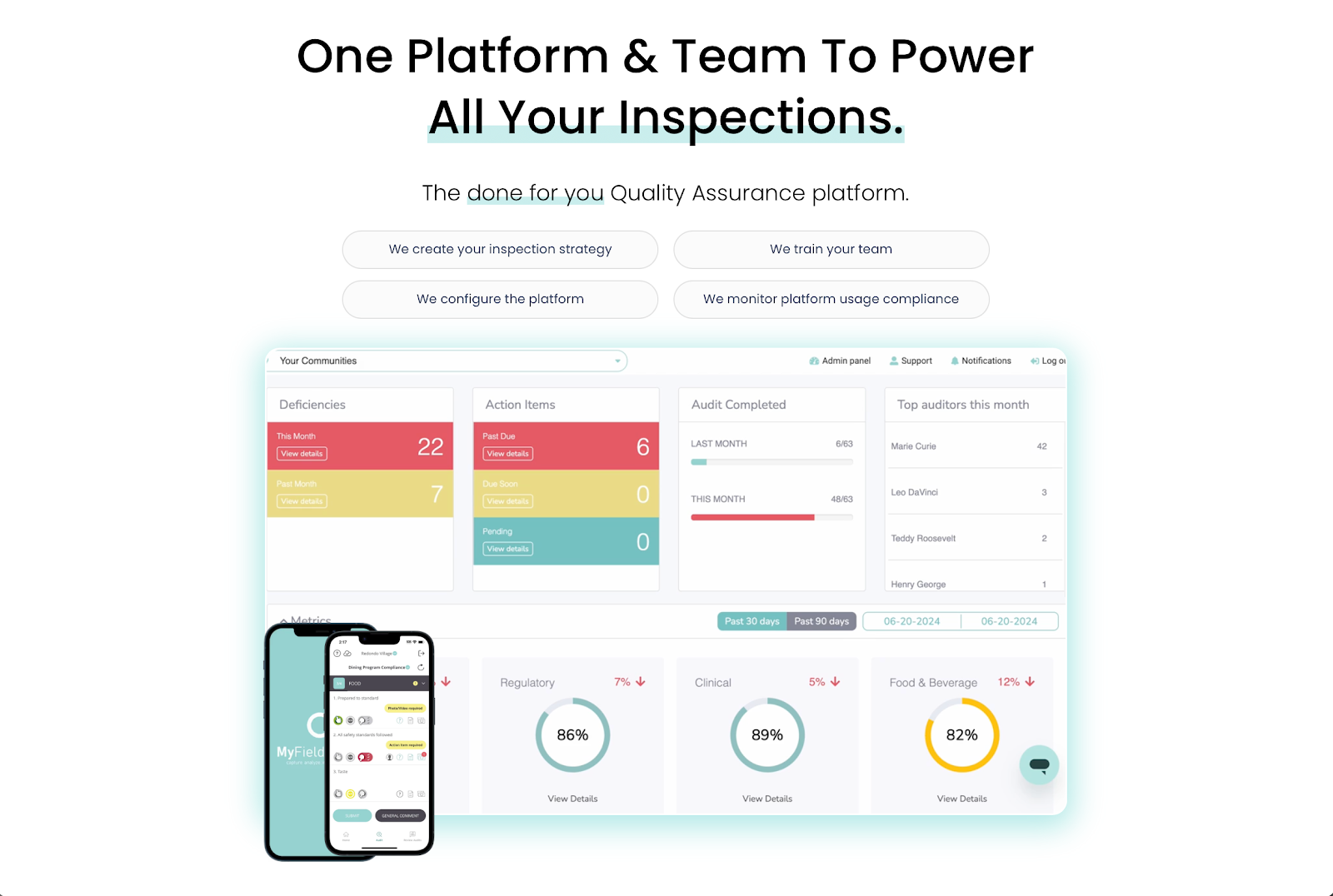.svg)
How to Build an HACCP Food Safety Checklist: 10 Elements

Take Control of QA.
Make Inspections Effortless.

We’ll quickly uncover your needs and share how we can help—no pressure, no stress, just solutions. Grab your spot on our calendar today!
Be survey-ready every day with three simple dining audits

We’ll quickly uncover your needs and share how we can help—no pressure, no stress, just solutions. Grab your spot on our calendar today!
If you're still using clipboards, binders, or spreadsheets to prepare for HACCP audits, you're making it harder than it needs to be. Paper logs tend to get lost, while some tasks are skipped.
When auditors show up, you're left scrambling to prove your team followed the seven basic principles of HACCP systems. That chaos only multiplies for food service management companies running multi-site locations.
Fortunately, HACCP audit checklists provide structure, real-time visibility, accountability, and proof of compliance. Everyone knows what’s expected, and your operations become easier to oversee.
This guide teaches you how to build an HACCP checklist that ensures efficient food safety management. You'll also learn the must-have elements to include in your checklist.
What Is an HACCP Food Safety Checklist?
An HACCP checklist helps your team follow food safety rules step by step. It is built around the HACCP system, which is short for Hazard Analysis and Critical Control Points.
You can use the checklist to track tasks, like temperature checks, cleaning, and food storage, and identify potential food safety hazards.
Each checklist item connects to a known risk and keeps your food production process audit-ready.
HACCP Checklist vs. HACCP Plan
After defining the HACCP checklist, you might be curious to know how it differs from an HACCP plan.
Think of your HACCP plan as the blueprint of your food safety management plan. It covers hazard analysis, critical control points, and all supporting documentation. You usually create it once, then update it when things change.
On the other hand, your HACCP checklist is what gets used on the ground. It breaks that big plan into daily tasks your HACCP team can follow line by line.
An effective HACCP plan sets the food safety regulations, while the checklist helps you follow them.
If you’re managing multiple sites, having a checklist keeps things organized. You don’t have to guess if the HACCP plan is working or chase down people for results. You get real-time visibility into what's happening across different locations.
10 Key Elements to Include in Your HACCP Food Safety Checklist
Now that you know what a checklist entails, it's time to learn what to put into it. Below are the must-have elements you should add:
1. Hazard Identification and Risk Assessment
Start by identifying potential hazards at each step of your food business process.
You need to watch out for biological, chemical, and physical hazards. These may include items such as bacteria on raw meat, cleaning chemicals near food preparation areas, or bones in fish fillets.
Here's a closer look at each specific hazard:
- Biological hazards: These are harmful organisms that can make people sick if they eat contaminated food. Common examples include bacteria, viruses, parasites, and fungi.
- Chemical hazards: Cleaning agents, pesticides, and other chemical substances shouldn't be in food. Meanwhile, allergens and food additives shouldn't be present in unsafe amounts.
- Physical hazards: Hard objects like metal shavings, glass fragments, plastic pieces, and bones don't belong in food. You should remove them to prevent injuries.
2. Critical Control Points
The next element to add is controlling food safety hazards.
You should determine critical control points (CCPs), or the exact steps where a hazard must be addressed to prevent unsafe food from reaching the customer.
Then, establish critical limits for each point to avoid foodborne illness and ensure ongoing compliance.
For example, when cooking raw materials, you should maintain the proper temperature to eliminate bacteria. Maintaining the correct temperatures is also important when cooling, storing, and reheating food.
Your checklist should not only show where the CCPs are. It should also define what safe food looks like and what to do if a foodborne hazard isn't properly controlled.
3. Control Logs
Once you’ve identified CCPs, you need to record the data. This is where monitoring procedures come in.
Use control logs to track key details like cooking temperatures, fridge readings, or sanitizer levels.
Make sure these logs are easy to read, quick to complete, and reviewed by supervisors daily. They will act as your audit trail and your safety net in case of a restaurant safety inspection.
If something goes wrong, logs will show you when it happened and what was done next.
They are especially valuable in a busy food business. By updating data in real time, these digital logs can save time and help you respond before the issue spreads across multiple locations.
4. Cleaning and Sanitation Procedures
Your HACCP checklist should also include scheduled cleaning tasks for every shift.
List the surfaces, tools, and kitchen equipment that need cleaning. Then, assign specific employee names and times to avoid confusion.
Don’t forget to add instructions for changing gloves and sanitizing utensils, especially when switching between raw and cooked items.
You should also require employees to wear personal protective equipment (PPE) and wash their hands often to mitigate potential risks when handling food.
Cleaning tasks and personal hygiene are often overlooked when kitchens get busy. Having a visible and easy-to-follow checklist keeps your team on track.
5. Staff Training and Food Handler Monitoring
Make sure your employees know how to follow the seven principles of your HACCP plan. If your staff isn’t adequately trained on these principles, your checklist won’t work.
Explain the HACCP process step-by-step and mention its importance during internal audits. Teach employees how to identify potential biological hazards and monitor CCPs.
Then, include line checks where your managers observe if kitchen staff follow food safety procedures, like proper handwashing or glove use.
6. Cross-Contamination Prevention
Your HACCP checklist should cover how to prevent raw materials from touching ready-to-eat items. That includes using color-coded cutting boards, changing gloves between tasks, and keeping raw meat stored on the bottom shelf of the fridge.
Add checks for cleaning tools between uses and sanitizing utensils when moving between different proteins.
Make these instructions visual and repeatable so that no matter who’s working the shift, the control measures don’t change.
7. Supplier and Receiving Checks
The safety of your food products starts before they reach your kitchen. Add the following checklist steps for inspecting food deliveries:
- Are packages intact without signs of damage or contamination?
- Are cold items at the right temperature?
- Do items have visible use-by dates and are within range?
- Are raw and ready-to-eat items separated properly during transport?
- Is the delivery manifest accurate?
- Does the driver have a clean and organized delivery vehicle?
If you accept poor-quality ingredients, no amount of in-house preparation or cleaning will fix the problem.
Carefully evaluate supplier delivery and log the results. Doing so helps you identify patterns, such as a supplier who's always showing up late or sending spoiled product.
8. Product Traceability and Recall
If something goes wrong with your food, you need to trace it back. That's why you should include product traceability procedures in your HACCP checklist.
Make sure to track batch numbers, dates received, and where ingredients were used. If a recall happens, you can pull the affected product quickly.
Without this essential step, you risk serving unsafe food and can’t prove where it went. You'll automatically fail HACCP audits and put your customers at risk.
9. Corrective Actions
Mistakes will happen. What matters is how you respond to issues.
Your checklist should spell out what to do when a problem is found, such as when cooked food doesn’t hit the required temperature or a cooler runs too warm.
Establish corrective actions, such as discarding the food, re-testing temperatures, or repairing broken kitchen equipment.
Then, add a line for logging the correction, who made it, and when. It also shows auditors that your team knows how to protect food operations from potential hazards.
10. Record Keeping
Your HACCP plan won't work without complete documentation. Make sure your checklist tracks when inspections happen, who completes them, and what was found during internal audits.
Store temperature sheets, cleaning logs, staff checks, corrective actions, and HACCP certifications in a secure yet accessible location. Then, keep these records for as long as your local regulations require, often one to two years.
Mobile inspection platforms like MyFieldAudits make this easier by keeping everything in one place. You can access documents anytime and get instant clarity on what's going on at your multi-site locations.
You can even show proof of performance to clients when they need it. This transparency helps you build stronger relationships and increase retention rates.
Watch this product overview to see MyFieldAudits in action!

How to Build an HACCP Checklist
Now that you know what to include, let’s walk you through how to create a practical checklist below:
Determine Relevant Stakeholders
Start your HACCP implementation by getting the right people involved. That includes food safety leaders, site managers, kitchen staff, and anyone who touches the inspection process.
You need input from the ground and from leadership. Since each team sees different parts of the operation and reports back, you can easily catch and address blind spots. Without their insight, you’re guessing at what matters most.
Make sure each stakeholder knows their role in the HACCP plan. Discuss how their input shapes food safety, product quality, and team accountability.
Map Your Food Process Flow
Before you can develop an HACCP checklist, you should understand how food moves through your operation.
Use a flow diagram to outline each step, such as receiving, storing, prepping, cooking, holding, and serving food.
Label steps clearly and include details, like equipment used or handoff points between staff members. This gives you a solid foundation for spotting hazards and deciding where checkpoints should go.
Standardized flow diagrams also help you apply consistent processes across different locations. This can bridge communication gaps and keep everyone in sync.
Conduct a Hazard Analysis
With your flow diagram in place, you can easily identify potential hazards at each step. These may be biological, chemical, or physical (like plastic fragments).
Use employee input and inspection history to identify areas where risks are most likely to occur. Then, decide how serious each risk is and whether it can be controlled or reduced to acceptable levels.
Rank them by likelihood and severity. For example, raw chicken that isn’t cooked to temp is high-risk and a clear violation of food safety standards. Meanwhile, a chip bag with a small tear is probably low-risk.
The goal is to spot hazards before they lead to unsafe food.
Use Digital Software
Paper-based checklists often get lost or ignored. They are also difficult to update, especially if you're running a multi-site food business.
Luckily, digital platforms like MyFieldAudits provide access to checklist templates that you can use anywhere at any time.
You can also conduct inspections in real time, log results, upload photos, flag issues, and trigger alerts when something goes wrong.
Plus, you can access dashboards that show progress, missed tasks, or trends across multiple locations. This helps your teams fix problems fast and gives leadership the reports they need without chasing people down.
Request a demo of MyFieldAudits today to keep quality assurance and compliance consistent through turnover!
Benefits of Using HACCP Checklists
After building your HACCP checklist, here’s what you can expect to gain from using it consistently.
- Increase operational visibility: Checklists help you see what’s happening at every site in real time. You catch small issues early and track performance across locations without chasing reports or missing key steps.
- Close communication gaps: With a checklist, everyone follows the same process. Your kitchen staff, auditors, and clients all speak the same language.
- Enhance team training: New employees ramp up faster when expectations are written out clearly. A checklist turns food safety regulations into daily habits that stick, helping reinforce skills through repetition and clarity.
- Maintain food safety compliance: By using HACCP checklists, you can easily prove that your process meets all regulatory standards. No need to search through outdated spreadsheets or scramble when auditors arrive.
- Build customer trust: Clients feel more confident when they see strong food safety practices. With documented verification activities and clean reports, you show that your operation is reliable, consistent, and inspection-ready.
Build Your HACCP Food Safety Program With MyFieldAudits
Trying to pass HACCP audits with paper checklists and scattered reports only creates more work for you and your team.
MyFieldAudits helps you build a consistent, audit-ready, and easy-to-manage HACCP food safety program across all locations.

Their mobile app provides real-time visibility into what's happening on the ground. You can conduct on-site inspections, share reports with clients, and capture data anywhere and anytime.
However, MyFieldAudits does not stop there. They act as your retention engine by managing the entire inspection process and delivering performance data that builds trust.
With MyFieldAudits, you don’t just meet expectations. You prove your value, strengthen operations, and keep your enterprise clients from walking away.
Schedule a demo today to get started! You can also watch this product overview video to learn more about MyFieldAudits.
FAQs About HACCP Food Safety Checklist
What are the seven HACCP principles of food safety?
The following seven principles guide all HACCP-based food safety systems:
- Conduct a hazard analysis
- Identify critical control points
- Establish critical limits
- Set monitoring procedures
- Plan corrective actions
- Create verification procedures
- Keep records and documentation
These principles provide a systematic approach to identifying and preventing problems before they affect food safety.
What are the 12 steps of HACCP?
The 12 steps of HACCP refer to five preliminary actions and the seven principles of HACCP. These initial steps include assembling a HACCP team, describing the product, identifying the intended use, developing a flow diagram, and validating the diagram's accuracy.
What type of checklist is recommended to comply with HACCP?
Use a HACCP-based, process-focused checklist that covers hazards, CCP monitoring, corrective actions, and records. Add sections for cleaning, food storage, allergen management, pest control, and staff hygiene. It's important to customize it for your operation's unique conditions and needs.
What are the seven most important food safety rules?
The seven essential food safety rules are washing hands often, cooking food to safe temperatures, preventing cross-contamination, storing food at proper temperatures, using safe raw materials, refrigerating food, and cleaning all kitchen surfaces.
%201.svg)






%201%20(1).svg)